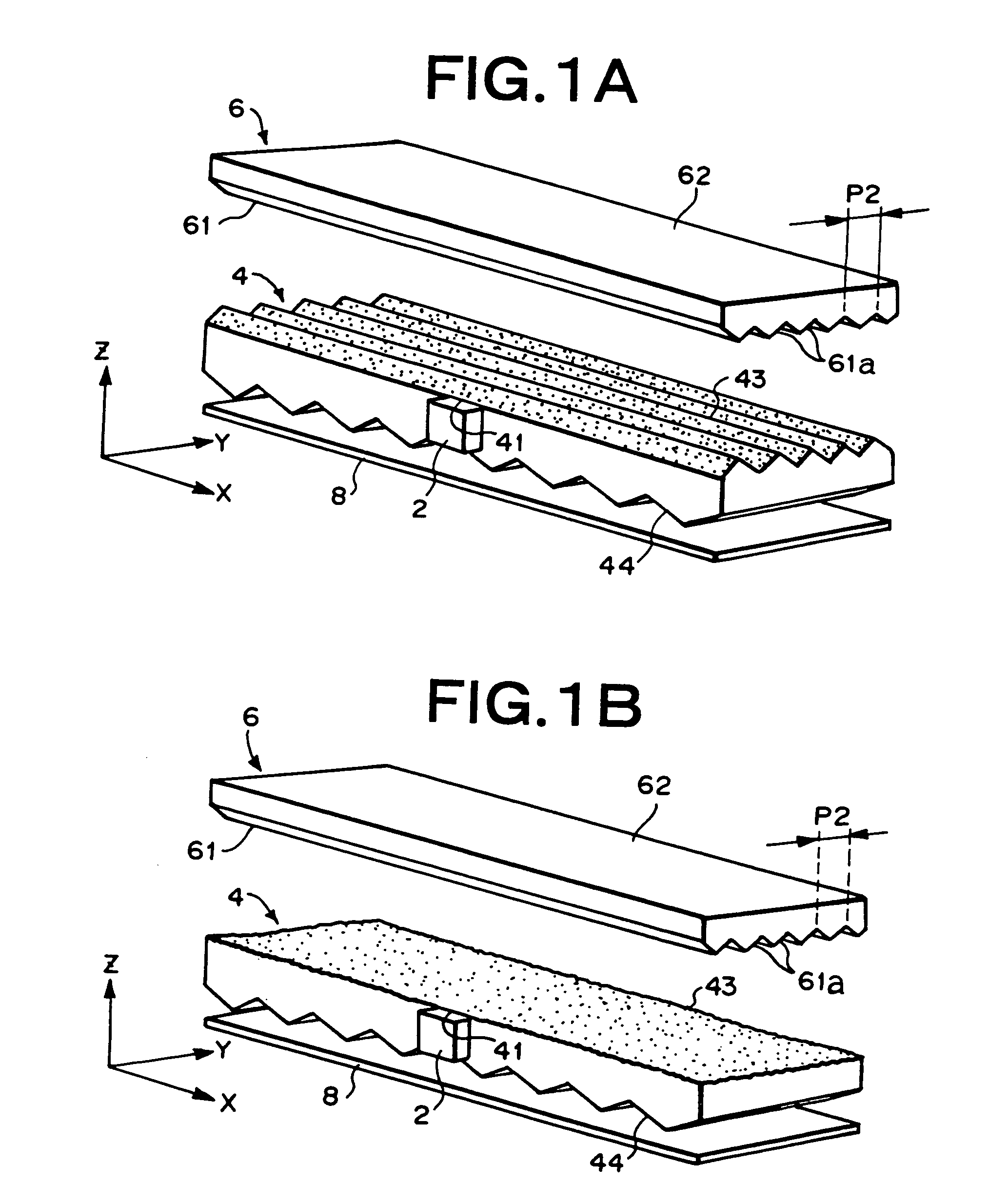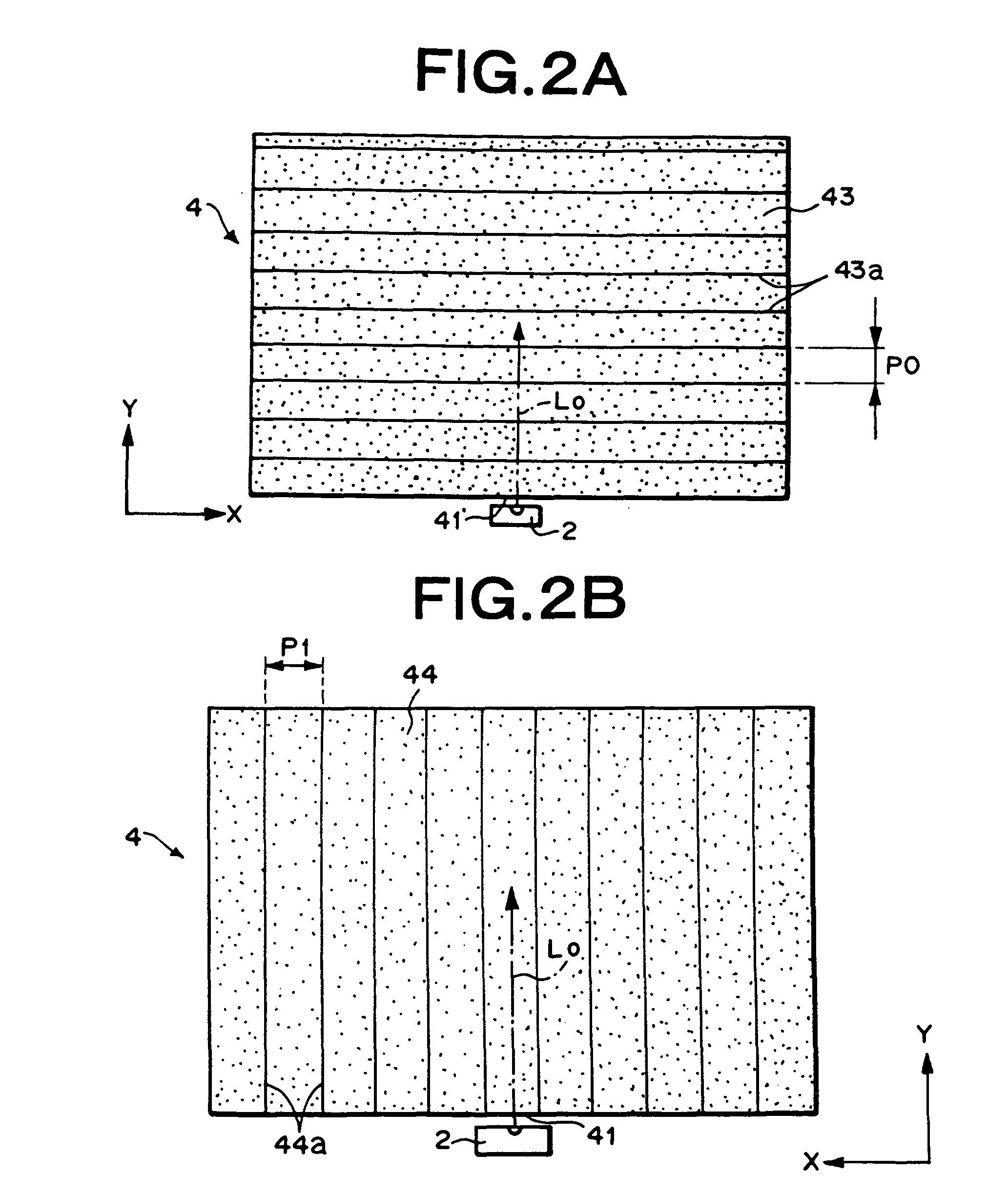Area light source and lightguide used therefore
a technology of light source and lightguide, which is applied in the direction of lighting and heating equipment, instruments, mechanical equipment, etc., can solve the problems of insufficient prevention of luminance reduction, non-uniformity of luminance distribution, and luminance lowering
- Summary
- Abstract
- Description
- Claims
- Application Information
AI Technical Summary
Benefits of technology
Problems solved by technology
Method used
Image
Examples
example 1
[0125]An elongated prism pattern in which elongated prisms having isosceles triangular sections of apex angles 172° and pitches of 50 μm were continuously disposed in parallel with a side of a length 34 mm was formed by cutting on a mirror-finished surface of a brass plate of an effective area 34 mm×48 mm and a thickness 3 mm. Then, the surface was roughened by using glass beads (FGB-400 by Fuji Manufacturing Co., Ltd.) of particle diameters of 53 μm or less, and subjecting the entire surface to blasting at a distance of 40 cm from the brass plate to a spray nozzle, and at spray pressure of 0.4 kgf / cm2. Thus, a first mold having a shape transfer surface of the roughened elongated prism pattern was obtained.
[0126]Additionally, a second mold made of a mirror-finished brass plate having an effective area of 34 mm×48 mm and a thickness of 3 mm was obtained.
[0127]Injection molding of a transparent methacrylic resin was carried out by using the first and second molds to manufacture a tran...
example 2
[0131]An elongated prism pattern in which elongated prisms having isosceles triangular sections of apex angles 1300 and pitches of 50 μm were continuously disposed in parallel with a side of a length 48 mm was formed by cutting on a mirror-finished surface of a brass plate of an effective area 34 mm×48 mm and a thickness 3 mm. Thus, a second T-old having a shape transfer surface of the elongated prism pattern was obtained.
[0132]By using the first mold used in the Example 1 and the above second mold, injection molding was carried out as in the case of the Example 1 to manufacture a transparent acrylic resin plate formed into a rectangle of a short side 34 mm and a long side 48 mm, and into a wedge shape whose thickness was changed from 1 mm to 0.7 mm along the long side, one surface of which had a first elongated prism formed surface having a roughened surface, and the other surface of which had a second elongated prism formed surface. This resin plate was set as a light guide.
[0133]...
example 3
[0135]A circular-arc elongated prism pattern in which circular-arc elongated prisms having isosceles triangular sections of apex angles 160° and pitches of 30 μm were concentrically formed around the vicinity of one corner of a square shape of 48 mm×34 mm, and flat parts of 30 to 200 μm were formed between every adjacent circular-arc elongated prisms so as to gradually narrow its width as the distance from the center increases was formed by cutting in an effective region of 40 mm×30 mm on a mirror-finished surface of a brass plate of 48 mm×34 mm and a thickness 3 mm. Then, the surface was roughened by using glass beads (FGB-400 by Fuji Manufacturing Co., Ltd.) of particle diameters of 53 μm or less, and subjecting the entire surface to blasting at a distance of 40 cm from the brass plate to a spray nozzle, and at spray pressure of 0.2 kgf / cm. Thus, a first mold having a shape transfer surface of the roughened elongated prism pattern was obtained.
[0136]By using the obtained first mol...
PUM
 Login to View More
Login to View More Abstract
Description
Claims
Application Information
 Login to View More
Login to View More - R&D
- Intellectual Property
- Life Sciences
- Materials
- Tech Scout
- Unparalleled Data Quality
- Higher Quality Content
- 60% Fewer Hallucinations
Browse by: Latest US Patents, China's latest patents, Technical Efficacy Thesaurus, Application Domain, Technology Topic, Popular Technical Reports.
© 2025 PatSnap. All rights reserved.Legal|Privacy policy|Modern Slavery Act Transparency Statement|Sitemap|About US| Contact US: help@patsnap.com



